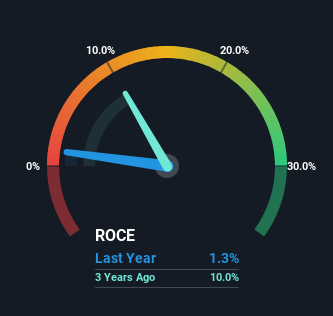- China
- /
- Electrical
- /
- SZSE:300602
Returns On Capital At Shenzhen FRD Science & Technology (SZSE:300602) Paint A Concerning Picture
What are the early trends we should look for to identify a stock that could multiply in value over the long term? Typically, we'll want to notice a trend of growing return on capital employed (ROCE) and alongside that, an expanding base of capital employed. If you see this, it typically means it's a company with a great business model and plenty of profitable reinvestment opportunities. In light of that, when we looked at Shenzhen FRD Science & Technology (SZSE:300602) and its ROCE trend, we weren't exactly thrilled.
Return On Capital Employed (ROCE): What Is It?
For those who don't know, ROCE is a measure of a company's yearly pre-tax profit (its return), relative to the capital employed in the business. To calculate this metric for Shenzhen FRD Science & Technology, this is the formula:
Return on Capital Employed = Earnings Before Interest and Tax (EBIT) ÷ (Total Assets - Current Liabilities)
0.013 = CN¥64m ÷ (CN¥7.3b - CN¥2.4b) (Based on the trailing twelve months to September 2023).
Thus, Shenzhen FRD Science & Technology has an ROCE of 1.3%. Ultimately, that's a low return and it under-performs the Electrical industry average of 6.4%.
Check out our latest analysis for Shenzhen FRD Science & Technology

In the above chart we have measured Shenzhen FRD Science & Technology's prior ROCE against its prior performance, but the future is arguably more important. If you're interested, you can view the analysts predictions in our free analyst report for Shenzhen FRD Science & Technology .
So How Is Shenzhen FRD Science & Technology's ROCE Trending?
The trend of ROCE doesn't look fantastic because it's fallen from 15% five years ago, while the business's capital employed increased by 274%. Usually this isn't ideal, but given Shenzhen FRD Science & Technology conducted a capital raising before their most recent earnings announcement, that would've likely contributed, at least partially, to the increased capital employed figure. Shenzhen FRD Science & Technology probably hasn't received a full year of earnings yet from the new funds it raised, so these figures should be taken with a grain of salt.
While on the subject, we noticed that the ratio of current liabilities to total assets has risen to 33%, which has impacted the ROCE. If current liabilities hadn't increased as much as they did, the ROCE could actually be even lower. Keep an eye on this ratio, because the business could encounter some new risks if this metric gets too high.
What We Can Learn From Shenzhen FRD Science & Technology's ROCE
Even though returns on capital have fallen in the short term, we find it promising that revenue and capital employed have both increased for Shenzhen FRD Science & Technology. These growth trends haven't led to growth returns though, since the stock has fallen 13% over the last five years. As a result, we'd recommend researching this stock further to uncover what other fundamentals of the business can show us.
If you want to continue researching Shenzhen FRD Science & Technology, you might be interested to know about the 3 warning signs that our analysis has discovered.
While Shenzhen FRD Science & Technology isn't earning the highest return, check out this free list of companies that are earning high returns on equity with solid balance sheets.
New: Manage All Your Stock Portfolios in One Place
We've created the ultimate portfolio companion for stock investors, and it's free.
• Connect an unlimited number of Portfolios and see your total in one currency
• Be alerted to new Warning Signs or Risks via email or mobile
• Track the Fair Value of your stocks
Have feedback on this article? Concerned about the content? Get in touch with us directly. Alternatively, email editorial-team (at) simplywallst.com.
This article by Simply Wall St is general in nature. We provide commentary based on historical data and analyst forecasts only using an unbiased methodology and our articles are not intended to be financial advice. It does not constitute a recommendation to buy or sell any stock, and does not take account of your objectives, or your financial situation. We aim to bring you long-term focused analysis driven by fundamental data. Note that our analysis may not factor in the latest price-sensitive company announcements or qualitative material. Simply Wall St has no position in any stocks mentioned.
About SZSE:300602
Shenzhen FRD Science & Technology
Shenzhen FRD Science & Technology Co., Ltd.
Solid track record with excellent balance sheet.
Similar Companies
Market Insights
Community Narratives



